The X Button
Beating Classics
by Todd Ciolek,

This column will take next week off so that I can wander around the New York Comic Con Anime Festival Pop Culture Cartoon Conglomerate. In the X Button's absence, feel free to read high literature, play video games, or watch a mediocre '80s anime film called Running Boy Star Soldier no Himitsu.
You must know that Running Boy Star Soldier no Himitsu isn't a particularly good movie. It's technically the story of a kid whose game-playing prowess helps Hudson win a virtual-reality war, but it's really all about promoting Hudson products, much like The Wizard advertised Nintendo in North America. The Wizard shilled Super Mario Bros. 3 and the Power Glove, and so Running Boy promotes Star Soldier and a new Hudson controller.
Running Boy is interesting only because of its minor place in game history. Along with Masami Hata's Super Mario Bros.: The Great Mission to Rescue Princess Peach, it was the first anime production based on a video game. The two films were released on the same day back in 1986, and while I can't find any direct evidence that they were shown on a double bill, it wouldn't surprise me. If that's true, I hope they had sense enough to run the slightly amusing Super Mario Bros. movie second, because there would be no other reason to sit through Running Boy.
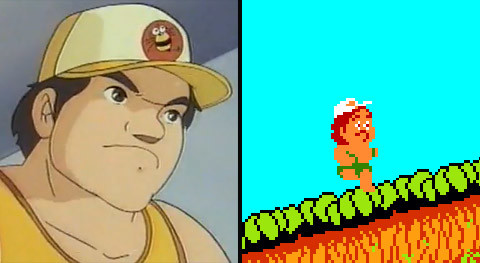
The other notable thing about Running Boy is the appearance of Takahashi Meijin. Just as Nintendo's Howard Phillips became a hero to American kids in the days of the NES, Takahashi Meijin was a celebrity in Japan, famous for the button-jabbing skills the let him fire 16 shots per second in Hudson shooters like Star Soldier. Hudson promoted Takahashi at every turn (he's currently a bigwig at the company) and even put him in their Adventure Island games, where America knew him as “Master Higgins.” In Running Boy Star Soldier no Himitsu, he's a steadfast lug who helps out at Hudson and picks bar fights with programmers.
Takahashi's appearance also answers my long-running question about that line on his face where his mouth should be. As this trifling anime movie reveals, it's Takahashi's resolute frown. I always thought it was a mustache, or perhaps an inverted nose or some strange facial scar.
NEWS
MEGA MAN LEGENDS 3 AND OTHER, LESS-DEMANDED GAMES ANNOUNCED FOR 3DS
Mega Man creator Keiji Inafune is a cruel man. When interviewed at the San Diego Comic-Con, he worried that Mega Man Legends 3 would be shunned by the fans if Capcom ever made the game. I assured him that I, at least, would buy it. Of course, Inafune hadn't yet announced that Legends 3 was coming and that it was for Nintendo's $300 3DS.
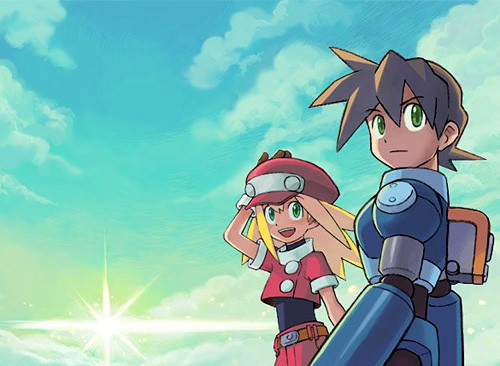
Little else is known about Mega Man Legends 3 right now, but it reunites the men behind the original Mega Man Legends semi-trilogy (counting The Misadventures of Tron Bonne). Legends 3 director Masakazu Eguchi sub-directed the second Legends, and producer Yoshinori Kawano was the main director of the first two Legends titles. So if Legends 3 is screwed up, it'll be screwed up by its original creators.
Mega Man Legends 3 was easily the biggest revelation about the 3DS last week, but Nintendo also laid down some details regarding the system's Japanese launch on February 26 of next year. The 25,000 yen price (roughly $300) gets you the unit, a desktop charge, styluses, cables, a 2GB SD card and six “Augmented Reality” cards for creating and storing games. It's doubtful that the American version will be much cheaper, but the system's capabilities should be the same. The 3DS can take 3-D pictures, communicate both casually and actively with other 3DS systems, play the DS and DSi libraries, and make Mii icons out of photographs. And the Japanese version comes in two colors: Cosmo Black and Aqua Blue.
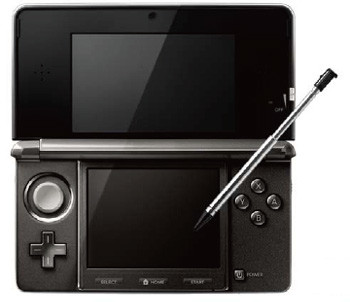
A lot of the 3DS titles explored last week were previously announced: a new Kid Icarus, a port of The Legend of Zelda: Ocarina of Time, Super Monkey Ball, Metal Gear Solid: Snake Eater 3D, Professor Layton and the Mask of Miracle, Samurai Warriors Chronicle, and a 3-D Super Street Fighter IV where you can passively fight other 3DS owners who just happen to be walking past. There's also a lineup of original Game Boy games for 3DS owners to download and optionally play in 3-D, reliving those fond memories of being stuck on a nine-hour car trip with only Home Alone and Solar Striker.
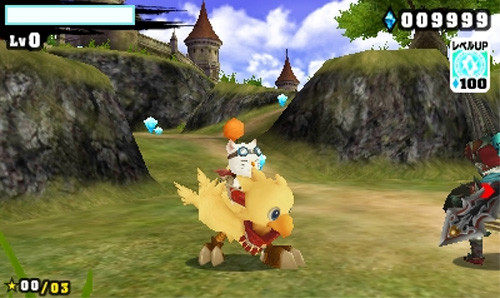
Square Enix's Chocobo Racing 3D at first looked like what everyone expected, with cute little moogles and white mages astride giant birds. But there's also an action-RPG mode in the game, and players gather various items to unleash spells and help them in races. It's come a long way since the middling Chocobo Racing on PSX, though I wouldn't expect any shocking revelations about moogle mobsters hiding the corpses of chocobos that lost one race too many.
Square also caught some attention by suggesting that Final Fantasy VII: Before Crisis might work well on the 3DS. An RPG originally designed for cell phones, Before Crisis is the one piece of Square's four-part Final Fantasy VII expansion that didn't make it here (the others being Advent Children, Dirge of Cerberus, and Crisis Core) even though it was promoted in North America. It's perhaps the least relevant part of the quadrilogy, as Before Crisis focuses on the conflicts between the Avalanche rebels and the corporate security force of the Turks. A mere port would be a little insulting on the 3DS, so perhaps a remake is a better idea.
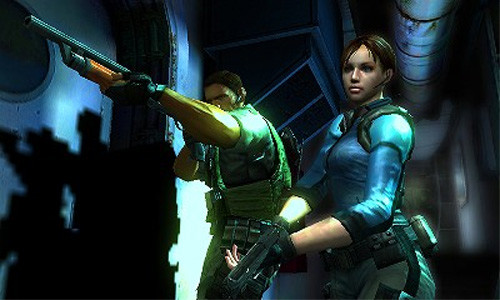
Capcom's major surprise was the prospect of two Resident Evil games for the 3DS. The first, Resident Evil Revelations, ties directly into Resident Evil 5, and the initial trailer shows Chris Redfield and Jill Valentine in a good ol' Mexican standoff. More attention is being paid to the trailer's visual quality than the idea of seeing two Resident Evil leads at each others' throats, as everything shown is apparently done by the 3DS hardware in real-time.
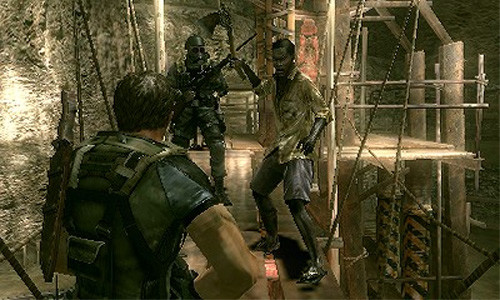
The other game, Resident Evil: The Mercenaries, stems from those Mercenaries bonus modes seen in the fourth and fifth Resident Evils. It looks a lot like a regular current-gen Resident Evil, but Capcom's promising worldwide multiplayer for the game, which would be quite an achievement for a first-generation 3DS title. Either way, The Mercenaries will surely help Capcom make Resident Evil a Resident Evil for the Resident Evily Resident Evils.
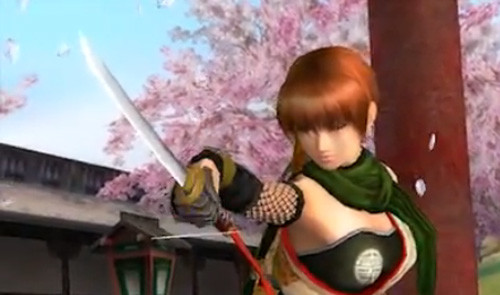
Tecmo's Dead or Alive series has avoided Nintendo systems so far, and that's why Dead or Alive Dimensions recaps the first four games in the franchise. This way, 3DS owners won't be lost as to the subtle history of how Hitomi doesn't like it when people kick dinosaurs in front of her. Layered plotlines aside, Dimensions looks sharp and has the tag-team fighting that perked up Dead or Alive's somewhat bland gameplay a while ago.
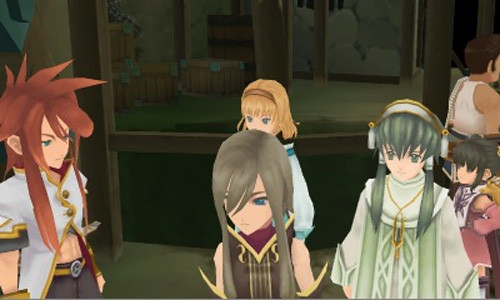
Namco's Tales of the Abyss stands out among Tales games for two reasons: it was released in North America, and, despite a billion new Tales games coming out every week, Abyss still has fans. So Namco's porting it to the 3DS and gauging just how well the system can handle anime-styled RPGs from the PlayStation 2. As shown above, the 3DS can clearly capture the “standing around stiffly and talking” scenes so vital to the genre.
And then there's Love Plus, the latest game to symbolize Japan's ongoing borderline-parody trend of phony virtual girlfriends. The series already saw releases on the DS and PSP (and inspired mock weddings in the process), and now there's a 3DS version to depict a giggling, supportive anime girl through the system's motion-sensors and 3-D capabilities. I'm sure this will be used only for dignified and harmless purposes by all concerned.
FIST OF THE NORTH STAR: KEN'S RAGE OUT IN NOVEMBER
Fist of the North Star may be a perpetual success in Japan, but it's routinely ignored by many North American companies. Well, Koei isn't one of those companies, and they're fast-tracking the recent PlayStation 3 and Xbox 360 Hokuto Musou game for a November 2 release under the title Fist of the North Star: Ken's Rage. Released in Japan earlier this year, Ken's Rage slaps the exploding-head chaos of Fist of the North Star inside a Dynasty Warriors model, giving Ken and nine other Fist stars the chance to gruesomely murder post-apocalyptic thugs by the truckload.

Koei naturally wants to keep Ken's Rage consistent with Sega's Last Battle, a censored American version of Fist of the North Star for the Genesis. That's why the North American version of Ken's Rage changes Ken's name to Aarzak, gives most of the characters neon hair or green skin, and removes all of the gore. Now defeated enemies will just fly off the screen instead of bursting apart.
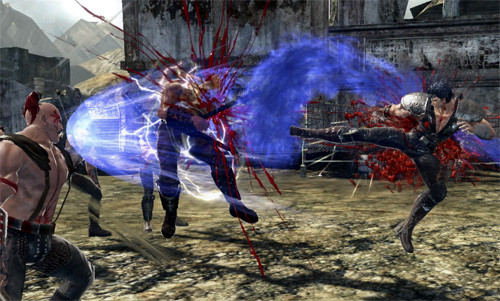
Joking. In fact, Ken's Rage will be even more violent than its Japanese counterpart. It'll also have an extra stage, tweaked controls for bike-riding, and voice acting in both English and Japanese. I can only hope they get James Avery (Uncle Phil in The Fresh Prince of Bel-Air and The Shredder in Teenage Mutant Ninja Turtles) to reprise his role from the original Fist of the North Star film. Interestingly, Koei's also going so far as to offer GameStop exclusives: the corpulent Mr. Heart and two extra levels are available only if you get the game there.
NEW FINAL FANTASY HAS NEW DRAGOON, NOT MUCH ELSE
It's hard to keep track of Square Enix's myriad Final Fantasy sequels, remakes, and spin-offs, but here's an easy way to remember Final Fantasy: Warriors of Light and Darkness: it's the one that most of this continent will never play. That's because it's a cell-phone RPG that builds an entirely new story with graphics straight out of a Super NES Final Fantasy. Much like Final Fantasy IV: The After Years, this RPG is divided into chapters. Each focuses on a different character, allied with the light or dark element, and finishing one story gives players a new class to assign party members in other chapters.
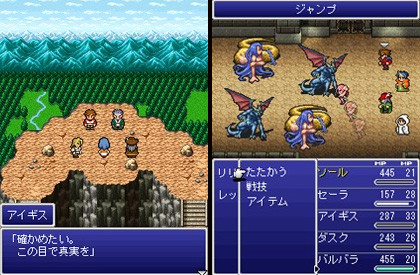
The initial characters for Warriors of Light and Darkness were stale: a village-boy hero, his mature-minded childhood sweetheart, a girl with Mysterious Powers, twins with vastly different personalities, the hero's absent instructor, an enigmatic wanderer, a vengeful swordsman, and a not-as-vengeful swordsman. The latest addition to the lineup is the most interesting one. She's Barbara, a redheaded, light-affiliated dragoon warrior and the only survivor from a village bombarded into oblivion by airships. She was raised by actual wyverns, which should lead to some odd character traits. It's a backstory that was easily found even back in 1994 (play Emerald Dragon), but Square at least put some effort into the artwork for Barbara. As the franchise's dragoons go, she's up there with Final Fantasy IV's Kain in design.
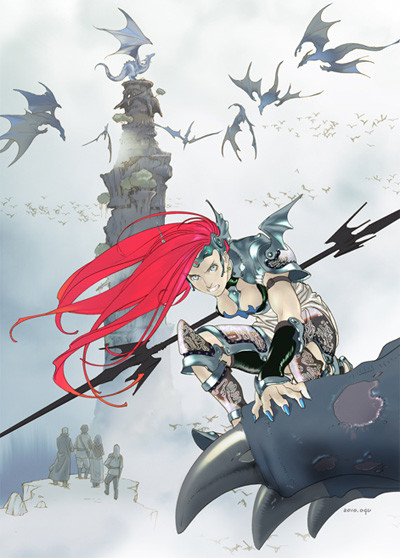
There's a slim chance that Square Enix will release Final Fantasy: Warriors of Light and Darkness over here, as The After Years was translated on WiiWare. For now, though, this new Final Fantasy will only reach Japan, where future chapters will hit the iMode and undervalue Barbara this winter.
REVIEW: CLADUN: THIS IS AN RPG
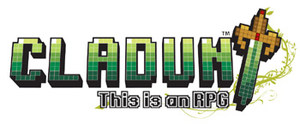 Developer: NIS
Developer: NIS
Publisher: NIS America
Platform: Sony PSP/PlayStation Network
Players: 1-4
MSRP: $19.99
Is ClaDun adorably old-fashioned or just cheap? It's easy to see it as a throwback to simple RPG graphics, but it's just as tempting to label the game a rather shameless hanger-on, inspired by recent basic-looking RPGs like 3D Dot Game Heroes. Yet beneath the pseudo-NES looks and self-mockery, ClaDun is still a dungeon hack, far more complicated than one might guess from its noseless character sprites and the nostalgia-tinged portmanteau of “Classic Dungeon.”
For one thing, ClaDun's story isn't much like those lauded RPGs from 1987, as ClaDun has actual characters. The first two we meet are the adventuresome Pudding and her worried friend Souma, who stumble across a pocket dimension at first occupied only by an irked witch, a talking egg, and pumpkins that thank the player for not squashing them. More allies soon filter into the world, bringing with them all the ingredients of a comically clichéd RPGs. There's one novel touch, at least: upon arrival, Souma can trigger the game's ending by walking through a door on the outskirts of the town, rolling the credits and leaving Pudding behind. Stick around, and Pudding will take over for the game's real goal: the dungeons.
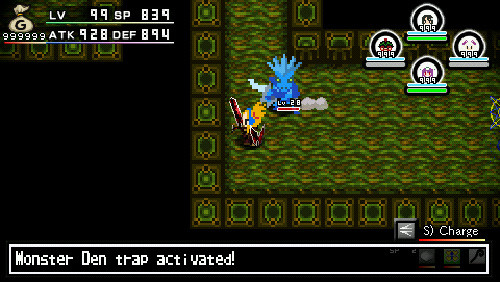
Every piece of ClaDun's little world points toward a massive, randomly generated dungeon that the characters are exploring just for the hell of it. The levels are as visually primitive as the rest of the game, but they hide all sorts of things: some traps bestow healing or speed, other just launch spikes and arrows, and some do both. While enemies are creatures of patterns, they're also situated carefully, and the game doesn't always force you to find the nastiest monster around to complete the level. Your character's also not grounded to one plane or method of attack: he or she can jump, charge up strikes, and edge around deviously to launch traps or lead enemies on.
ClaDun's real depth lies in its peripheral characters. While only one main player avatar is shown on screen, others join as unseen supporters when they're placed around the main explorer on the options screen. Each ally gains different stat boosts and decreases depending on the position, and dragging them into dungeons helps them level-up along with the lead character. It's an intriguing simplification of the party-building system common in other dungeon hacks, and it brings much-needed dimension to the game.
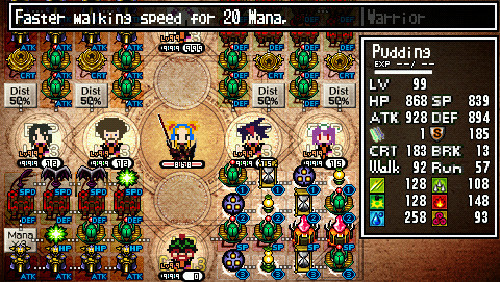
Of course, ClaDun is still primitive in other ways. The game resembles an independent little creation, looking on par with the original Cave Story. There's nothing wrong with abstract simplicity, but the wide screen of the PSP makes the game look worse than it would on a DS or cell phone. The soundtrack is less lazy; it's modern in its composition, but there's an option to hear a primitive version for however long you can stand it. There's one payoff to the basic appearance: a character-creation system where you can edit a protagonist one pixel at a time, with a later option to redesign the game's final boss.
It's a shame that ClaDun doesn't let players remake the dungeons themselves. They're randomly generated from blocky architecture, and they're often dull. Some prove good challenges, but the game takes a little too long to vary itself from the usual grind. ClaDun's all starchy dungeon-hacking, with little draw beyond the rhythms of its gameplay. Good thing there's a four-player mode to give even drab stages a competitive appeal.
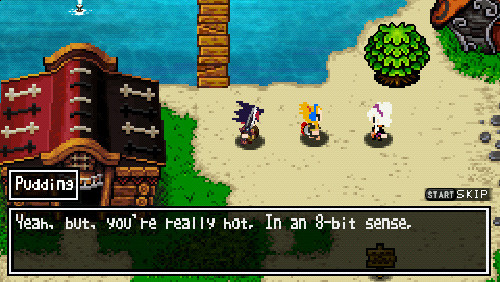
Yet the game's few frills are enjoyable. ClaDun doesn't dress itself in serious tones, and even commonplace items reveal bizarre descriptions (it seems that every barrel in the game world has its own story). NIS America translated the limited dialogue well enough, even if it plays up the game's already too-cute attitude of acknowledging just how intensely retrogressive it is.
ClaDun can't reach the detailed dungeon forays of Shiren the Wanderer or Etrian Odyssey, and perhaps it doesn't even try for that. This is an RPG indeed, one in its most compact, basic, and unadorned incarnation. It's a pleasure in a small way, but it's also a reminder that RPGs sometimes need more than just good mechanics.
NEXT WEEK'S RELEASES
LUFIA: CURSE OF THE SINISTRALS The original Lufia II: Rise of the Sinistrals was the last pure RPG released in English for the Super NES, and it made for excellent farewell back in 1996. Its puzzle-driven dungeons and non-random battles were welcome breaks from the RPG norm, and even the storyline took a bold step or two. Neverland told bolder steps in deciding to remake the game for the DS, and their new creation definitely isn't the Lufia II we remember. Sure, it's still about a red-haired warrior named Maxim who goes after the godlike world-wreckers called Sinistrals, and he still falls for a magic-wielding woman named Selan. Yet many of the characters are redesigned, some more drastically than others: Maxim's childhood friend Tia now resembles a manic toy engineer, and at least one supporting comedy-relief thief became a woman. Even more extensive is the gameplay. No longer a straight, menu-driven RPG, Curse of the Sinistrals is an action-driven RPG, where each characters uses a special tool and an elemental attack to solve puzzles and fend off enemies. It's a refreshingly extensive revamp of an old favorite, though early reports suggest that the Japanese version is a mess. At least any Lufia fan's expectations are low after that Ruins of Lore crap hit the Game Boy Advance.
|
SENGOKU BASARA: SAMURAI HEROES  Developer: Capcom
Developer: CapcomPublisher: Capcom Platform: PlayStation 3/Wii Players: 1-2 MSRP: $39.99 Capcom likely wants everyone to forget the first North American release of Sengoku Basara, or “Devil Kings” as it was so extensively renamed. All of the game's Japanese-warrior characters were recast as fantasy heroes, and that didn't go over too well. Things are different now. Sengoku Basara has a decent following in Japan, FUNimation has the anime series, and Capcom has good reason to bring out a game unaltered. Of course, Sengoku Basara will look familiar to fans of Koei's Samurai Warriors lines, as Capcom's large-scale brawlers cover the same period in Japanese history. But while the characters overlap, Sengoku has its own style of interpreting figures like Masamune Date and Sanada Yukimura. That style has won the series a significant number of female fans in Japan, but one doesn't need a library of lewd doujinshi to appreciate the colorful multiplayer violence of Sengoku Basara. While it's limited to two players, the co-op battles make for some engaging challenges, and they can be taken online in the PlayStation 3 version. This is Sengoku Basara's real debut in North America, and one can't say that Capcom is hiding it this time.
|
discuss this in the forum (40 posts) |
this article has been modified since it was originally posted; see change history
 Developer: Neverland Company
Developer: Neverland Company